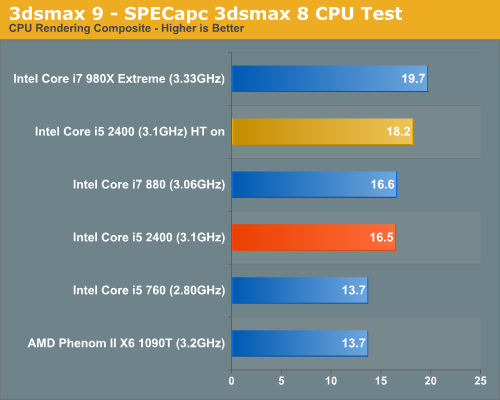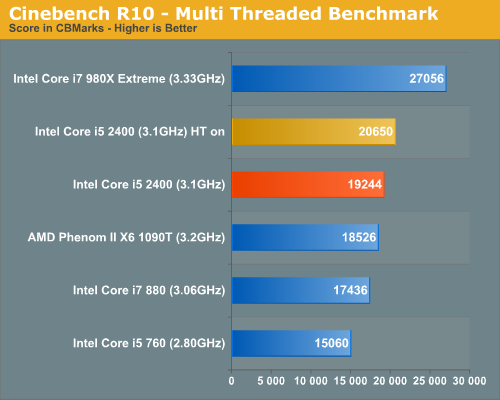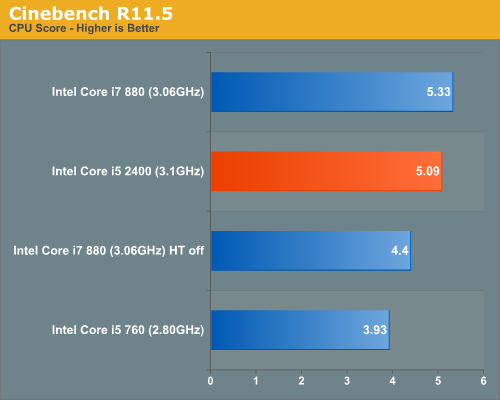The Sandy Bridge Preview
by Anand Lal Shimpi on August 27, 2010 2:38 PM EST3dsmax 9 - SPECapc 3dsmax CPU Rendering Test
Today's desktop processors are more than fast enough to do professional level 3D rendering at home. To look at performance under 3dsmax we ran the SPECapc 3dsmax 8 benchmark (only the CPU rendering tests) under 3dsmax 9 SP1. The results reported are the rendering composite scores:

This is another one of those situations where the Core i5 2400 without Hyper Threading is able to perform on par with the Core i7 880 with Hyper Threading. Compared to the i5 760 it’s 20.5% faster.
With Hyper Threading enabled, the Core i5 2400 is actually dangerously close to the 6-core 980X. Whatever Intel has done to Sandy Bridge's FP is big.
Cinebench R10
Created by the Cinema 4D folks we have Cinebench, a popular 3D rendering benchmark that gives us both single and multi-threaded 3D rendering results.

Cinebench was particularly surprising because it gives us a good opportunity to look at single threaded FP performance. Compared to a similarly clocked Lynnfield, Sandy Bridge can deliver 11% better performance. Compared to a similarly positioned Lynnfield, Sandy Bridge is about 20% faster. Note that this is without turbo enabled. The retail 3.1GHz chip should turbo up to 3.4GHz in this test, giving it a 9.6% frequency boost.
In the multithreaded test Sandy Bridge’s per-core performance is even better than Lynnfield with HT enabled.

I also ran a few numbers using Cinebench R11.5. I didn’t have the opportunity to test the i5 2400 with HT enabled in this test so I measured performance of the i7 880 with HT enabled/disabled to compare per-thread performance.

Sandy Bridge's FP performance is very good. Clock for clock we see a 15.6% improvement over Lynnfield (4C/4T vs. 4C/4T). Compared to the proposed similarly priced Core i5 760, the i5 2400 would be 29.5% faster.
POV-Ray 3.73 beta 23 Ray Tracing Performance
POV-Ray is a popular, open-source raytracing application that also doubles as a great tool to measure CPU floating point performance.
I ran the SMP benchmark in beta 23 of POV-Ray 3.73. The numbers reported are the final score in pixels per second.

The similarly positioned/priced Core i5 760 is beat by 17%. There’s no replacement for more cores/threads however as the i7 880 and X6 parts both pull ahead. Turn on HT to level the playfield (at least within Intel) and Sandy Bridge is 15% faster than Lynnfield.










200 Comments
View All Comments
Anand Lal Shimpi - Friday, August 27, 2010 - link
You're correct, I didn't feel a dual vs. quad-core comparison was fair which is why I focused on the 760. I'll clear up the text though :)Take care,
Anand
Anand Lal Shimpi - Friday, August 27, 2010 - link
fixed :)mastrdrver - Friday, August 27, 2010 - link
If we go with what Anand has said and use the roadmap to guess pricing I just have one question then:Why in the world would anyone spend ~$300 for the 2500 and ~$500 on the 2600 then use the on chip gpu with no plans on some kind of discrete?
If the difference between a $600 HP is Llano and Sandy Bridge, Llano has a possibly huge advantage since I think its safe to assume that the gpu side will start at 5450 performance.
Its like Intel would be trying to tell you that SD Xbox 360 is better than HD Xbox 360 (Llano). Are you serious? If Llano can hit a pc at that price point and have a full shader count, Sandy Bridge is dead in the consumer market.
I know that's a lot of ifs and time between here and then but Intel doing what it has always done with graphics (suck) is going to haunt it. I think Intel let the door wide open and its head between it and the frame. All AMD has to do is shut it.
DanNeely - Friday, August 27, 2010 - link
There are people whose workloads are heavily CPU bound but who don't need a heavy duty GPU. Higher end servers and a lot of workstations fall into this category.Beyond that unless Intel made a GPUless die or deliberately disabled the onboard GPU there's no reason not to include it. While we'll have to wait until Intel shows off labeled die shots I doubt that the GPU is a large enough chunk to justify the engineering effort just to save a little on the manufacturing side.
mastrdrver - Saturday, August 28, 2010 - link
You are correct but my point was meant to be on "Best Buy" systems and not server or workstations. Sorry if I didn't get that clear.On the server front this will have to go up against Bulldozer which is an entirely different topic.
While it would be foolish for Intel to make a gpuless die since integration with the cpu side is inevitable, Larabee or what ever better be good. Then there is the driver thing. That Dragon Age Origin picture sure doesn't look right. For drivers that still have work to do, that picture looks exactly like the one from when Clarkdale was released. I'd be a little surprised if much driver work is left if those two pictures are actually different.
arh2o - Friday, August 27, 2010 - link
How much will these new 1155 motherboard prices be? Will they be in the same price range as the current 1156 motherboards?Rajinder Gill - Saturday, August 28, 2010 - link
I'd imagine the P67 boards will be priced between $150~$200.odin607 - Friday, August 27, 2010 - link
What about temps =(cmdrdredd - Friday, August 27, 2010 - link
I'm never buying an Intel CPU or Motherboard ever again. This is one area that made them what they are today. The ability to take a mid range part and clock it up is what made the Core 2 series such a success with gamers and other performance enthusiasts. Not all of the success is attributed to overclocking, but a good bit of the popularity came from a $200 CPU being able to clock up to levels that the $700+ cpus hit. Now, if the unlocked parts can hit big overclocks and aren't overpriced then maybe it'll work out. However, it's all to easy for Intel to give us the finger and price a $200 CPU at $600 because it's unlocked and say "tough crap, if you want to overclock then pay up!". I am hopeful it doesn't come to this.Anyway, quads are old news IMO...I'm looking at 6core for my next one.
JumpingJack - Saturday, August 28, 2010 - link
"but a good bit of the popularity came from a $200 CPU being able to clock up" ...Reading the preview, it looks like the 2500K may fit this description.
From the articles:
"...and the 2500K will replace the i5 760/655K ($205 - $216). ..."
Even the 875K, when it launched, wasn't as you claim... it actually came in 200 bucks cheaper than the 870.
http://techreport.com/articles.x/18988
It would seem to me that Intel has been planning this change for sometime and went out to address this....